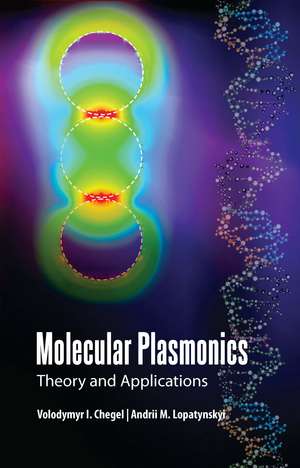Molecular Plasmonics: Theory and Applications
Editat de Volodymyr I. Chegel, Andrii M. Lopatynskyien Limba Engleză Hardback – 19 noi 2020
Preț: 795.23 lei
Preț vechi: 1062.72 lei
-25% Nou
Puncte Express: 1193
Preț estimativ în valută:
152.18€ • 165.25$ • 127.84£
152.18€ • 165.25$ • 127.84£
Carte tipărită la comandă
Livrare economică 23 aprilie-07 mai
Preluare comenzi: 021 569.72.76
Specificații
ISBN-13: 9789814800655
ISBN-10: 9814800651
Pagini: 420
Ilustrații: 47 Line drawings, color; 119 Line drawings, black and white; 3 Tables, black and white; 47 Illustrations, color; 119 Illustrations, black and white
Dimensiuni: 152 x 229 x 25 mm
Greutate: 0.94 kg
Ediția:1
Editura: Jenny Stanford Publishing
Colecția Jenny Stanford Publishing
ISBN-10: 9814800651
Pagini: 420
Ilustrații: 47 Line drawings, color; 119 Line drawings, black and white; 3 Tables, black and white; 47 Illustrations, color; 119 Illustrations, black and white
Dimensiuni: 152 x 229 x 25 mm
Greutate: 0.94 kg
Ediția:1
Editura: Jenny Stanford Publishing
Colecția Jenny Stanford Publishing
Public țintă
Academic and Professional Practice & DevelopmentCuprins
1. Molecular Plasmonics 2. Physics of the Phenomenon and Theoretical Background of Surface Plasmon Resonance Method 3. Plasmonic Nanochips Development and Applications 4. Peculiarities of Surface Plasmon Resonance Method Application for the Investigation of Biomolecules and Biomolecular Interactions 5. Application of Molecular Imprinting for Development of Plasmonic Bio- and Chemosensors 6. Electrochemical Surface Plasmon Resonance and its Applications in Biosensing, Bioelectronics, and Material Science 7. Studies of Conformational Changes in Molecular Systems using Surface Plasmon Resonance 8. Gold Nanoparticle Modification and Aggregation – Applications from Bio- and Chemosensing to Drug Development 9. Metamaterials with Reversible Optoelectronic and Physicochemical Properties
Notă biografică
Volodymyr I. Chegel is head of the Plasmonics Group at the V. E. Lashkaryov Institute of Semiconductor Physics (ISP), National Academy of Sciences (NAS) of Ukraine, and a professor at the Taras Shevchenko National University of Kyiv (KNU), Ukraine. He completed an MSc in physical engineering at the Volodymyr Dahl East Ukrainian University and also in integral and functional microelectronics at the KNU. He earned his PhD and DSc in physics and mathematics at the ISP. He has worked in the scientific laboratories of 17 countries and authored or co-authored more than 200 research papers. Prof. Chegel’s research interests include plasmonics, nanotechnology, materials science, biological and chemical sensors, and design of optoelectronic devices.
Andrii M. Lopatynskyi is a senior researcher at the Department of Functional Transducers for Sensor Technology at the ISP. He earned his MSc in laser and optoelectronics technologies from the KNU and PhD in physics and mathematics from the ISP. He has worked as an intern researcher in the National Institute for Materials Science, Tsukuba, Japan, and has co-authored more than 100 scientific research papers. Dr. Lopatynskyi’s research interests include development, experimental investigation, and computational modeling of the optical properties of disordered and ordered plasmonic nanosystems based on noble metal nanostructures, as well as development of sensors based on these nanosystems.
Andrii M. Lopatynskyi is a senior researcher at the Department of Functional Transducers for Sensor Technology at the ISP. He earned his MSc in laser and optoelectronics technologies from the KNU and PhD in physics and mathematics from the ISP. He has worked as an intern researcher in the National Institute for Materials Science, Tsukuba, Japan, and has co-authored more than 100 scientific research papers. Dr. Lopatynskyi’s research interests include development, experimental investigation, and computational modeling of the optical properties of disordered and ordered plasmonic nanosystems based on noble metal nanostructures, as well as development of sensors based on these nanosystems.
Descriere
This book compiles and details the wide-ranging research in different approaches to the field of molecular plasmonics from international interdisciplinary teams of researchers who are currently establishing these novel optoelectronic techniques through the development of basic theoretical methods and experimental protocols.













